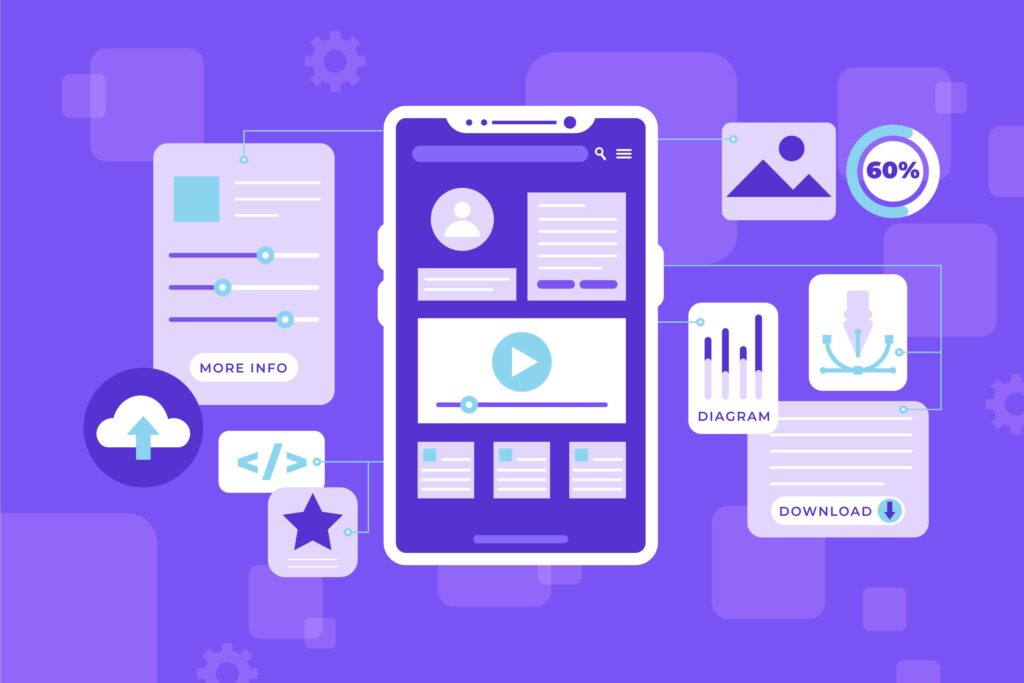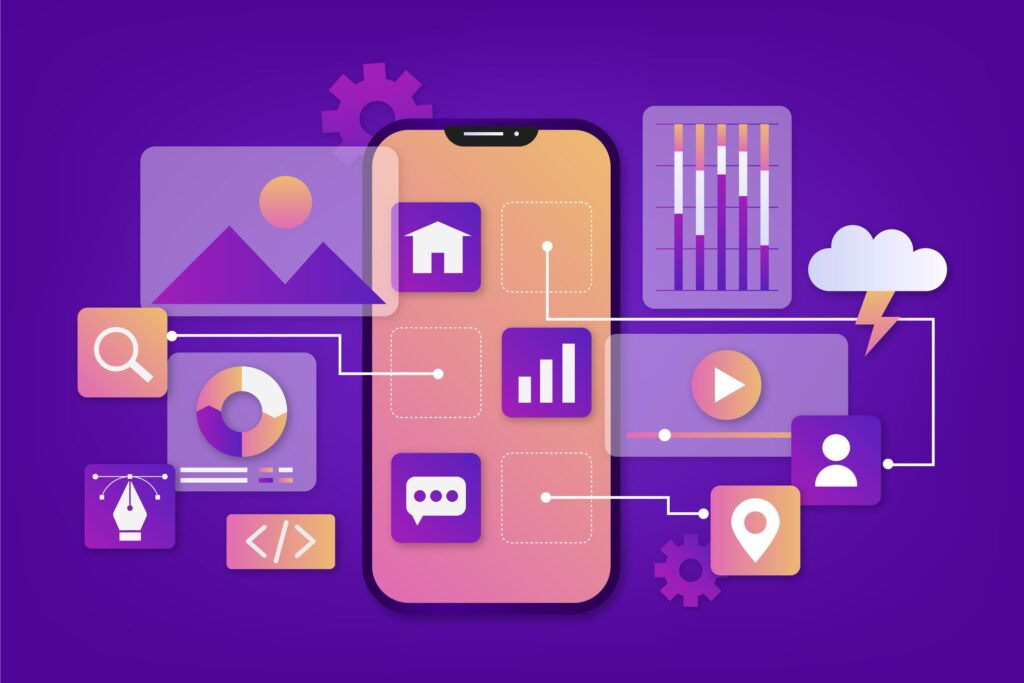Introduction to Mobile Apps Evolution
A Brief History: Mobile apps
Mobile applications have a brief but impactful history, dating back to the late 1990s with rudimentary apps on early smartphones. Platforms like Palm OS and BlackBerry OS set the stage for basic mobile functions like email and calendar apps. However, it wasn’t until the launch of Apple’s App Store in 2008 that mobile app development truly took off. This marked the beginning of a rapid expansion in both the quantity and quality of mobile apps. It was fueled by advancements in technology and a growing demand for mobile solutions across various industries.
Definition and Scope: Mobile Apps
The definition and scope of mobile apps evolution involve creating, distributing, and using software applications for mobile devices. These applications serve a wide range of purposes, from entertainment and productivity to commerce and communication.
Enhanced Connectivity: Breaking Geographical Barriers
Enhanced connectivity through mobile apps has revolutionized how people communicate, effectively breaking geographical barriers.
Real-Time Communication Platforms
Real-time communication platforms refer to software applications that facilitate instantaneous exchange of messages, audio, and video content between users. These platforms enable users to engage in conversations and interact with others in real-time, regardless of their physical location. Examples include messaging apps like WhatsApp, Telegram, and Facebook Messenger, as well as video conferencing tools like Zoom and Skype.
Global Impact on Relationships
The global impact of mobile communication platforms on relationships has been profound.
These platforms have transcended geographical boundaries, enabling individuals to maintain and nurture connections with friends, family, and colleagues globally. Through messaging apps, social media platforms, and video conferencing tools, people can stay in touch in real-time, regardless of distance.
Formation of Online Communities: Building Digital Tribes – Mobile Apps

Social networking apps play a crucial role in facilitating connections and interactions between individuals and communities in the digital realm. These apps offer platforms for creating profiles, sharing content, and engaging with others based on interests or relationships. Users can connect with friends, family, colleagues, and even strangers, expanding their social circles and networks.
Role of Social Networking Mobile Apps
Social networking apps play a crucial role in facilitating connections and interactions between individuals and communities in the digital realm. These apps offer platforms for creating profiles, sharing content, and engaging with others based on common interests, affiliations, or relationships. Users can connect with friends, family, colleagues, and even strangers, expanding their social circles and networks.
Impact on Interpersonal Connections
The impact of social networking apps on interpersonal connections has been significant, altering how people communicate and relate. These apps have facilitated the formation and maintenance of relationships by providing convenient and accessible platforms for interaction. Users can connect with others instantaneously, regardless of geographical distance, fostering a sense of closeness and interconnectedness.
Virtual Collaboration Tools
Virtual collaboration tools are software applications designed to facilitate teamwork and communication among individuals who are not physically co-located. These tools offer various features for collaboration, such as file sharing, document collaboration, project management, video conferencing, and messaging. Examples of virtual collaboration tools include platforms like Slack, Microsoft Teams, Google Workspace (formerly G Suite), and Trello.
Breaking Down International Barriers
Breaking down international barriers involves overcoming obstacles that hinder communication, collaboration, and commerce between individuals and businesses globally. Mobile applications have played a crucial role in this process by providing tools and platforms that facilitate cross-border interactions. These applications facilitate real-time communication, information sharing, transactions, and collaboration across different locations.
Transforming Commerce: The Rise of Mobile Shopping
The rise of mobile shopping signifies a transformative shift in commerce, fueled by the widespread adoption of mobile applications. It offers unparalleled convenience and accessibility, allowing consumers to browse, purchase, and manage products and services from their mobile devices.
Accessibility and Convenience
Accessibility and convenience are key in mobile shopping, allowing easy browsing and purchasing anytime, anywhere. Mobile apps revolutionize retail by offering instant access to products and services via smartphones and tablets. With a few taps, consumers can browse catalogs, compare prices, read reviews, and make purchases without the limitations of physical stores or traditional hours. This level of accessibility and convenience has transformed how people shop, making it more convenient and efficient than ever before. Whether at home, on the go, or even during their daily commute, consumers can now enjoy a seamless shopping experience right at their fingertips.
Influence on Consumer Behavior
Mobile shopping has a significant influence on consumer behavior, shaping the way people discover, evaluate, and purchase products and services. The convenience and accessibility of mobile apps have led to shifts in consumer preferences and shopping habits. Mobile shopping provides access to a wealth of information at consumers’ fingertips, enabling them to research products, compare prices, read reviews, and make informed purchasing decisions on the go.
Streamlined Payment Methods: Cashless Transactions
Streamlined payment methods involve cashless transactions through mobile apps, transforming financial transactions. The rise of mobile wallets and digital platforms enables convenient purchases, money transfers, and financial management via smartphones. These cashless transactions offer numerous benefits, including convenience, security, and efficiency.
Mobile Wallet Solutions
Mobile wallet solutions securely store payment information on mobile devices, linking bank accounts, credit cards, and other payment methods. This provides a convenient way to make purchases, send money, and manage finances on the go. Popular examples include Apple Pay, Google Pay, Samsung Pay, and banking apps with mobile payment features.
Security and Efficiency
Security and efficiency are paramount considerations in the realm of mobile applications, particularly concerning financial transactions and personal data management. Mobile apps prioritize security through encryption, authentication mechanisms, and security layers to protect users’ sensitive information. These measures ensure secure transactions and data interactions, enhancing user confidence in privacy and security.
Personalized Shopping Experiences: Tailoring to Preferences

Personalized shopping experiences refer to the customization of the shopping journey based on individual preferences, behaviors, and past interactions. Mobile applications employ techniques like data analytics, machine learning, and user profiling to customize product recommendations and content. Analyzing user data enables apps to deliver targeted content, enhancing the shopping experience.
Data Analytics in E-commerce
Data analytics is crucial in e-commerce, providing insights from online transactions, customer interactions, and website activities. Leveraging data analytics tools enables companies to analyze trends, patterns, and customer behavior to optimize strategies. These insights inform product recommendations, pricing, marketing, inventory management, and customer segmentation.
Enhancing Customer Satisfaction
Enhancing customer satisfaction is a primary goal for businesses in e-commerce. Data analytics plays crucial role in achieving this objective by analyzing customer feedback, purchase history, browsing behavior, and other data. This information helps businesses tailor their products, services, and experiences to better meet customer needs and expectations. This might involve offering personalized recommendations, improving website navigation, optimizing product listings, or providing responsive customer support.
Addressing Mobile Apps Challenges: Securing the Mobile Realm
Securing the mobile realm is crucial to protect user data and applications. Given the reliance on mobile devices for communication, transactions, and personal data storage, addressing security challenges is paramount. Developers and security experts use strategies and technologies to enhance security in the mobile realm.
Security Concerns
Security concerns in mobile applications are a significant focus, given the sensitive nature of data and transactions on mobile devices. These concerns encompass various threats, including malware, phishing attacks, data breaches, and unauthorized access to personal information. Mobile app developers and security experts must address these concerns by implementing robust security measures to protect users data.
Compatibility Issues
Compatibility issues in mobile applications arise when an app is not compatible with specific devices, OS versions, or software. These issues can lead to functionality errors, performance issues, or app crashes, affecting user experience and app reach. To tackle compatibility issues, developers consider device specs, screen sizes, OS versions, and hardware capabilities during app design and testing.
Mobile Apps Future Trends: Innovations Reshaping the Landscape
Future trends in mobile applications are driven by continuous innovation, shaping the landscape of technology and user experiences. Several emerging technologies are poised to revolutionize the mobile app ecosystem, including:
Augmented Reality (AR):
AR technology overlays digital content onto the real world, enhancing user interactions with their environment. AR has applications in gaming, education, retail, and more, offering immersive experiences and enhanced engagement.
Artificial Intelligence (AI):
AI-powered mobile apps trends utilize machine learning algorithms to analyze data, predict user behavior, and deliver personalized experiences. AI enables intelligent assistants, chatbots, and recommendation engines, improving efficiency and user satisfaction.
Internet of Things (IoT):
IoT integration with mobile apps connects smart devices and sensors, enabling remote monitoring, control, and automation of various systems. IoT-powered apps have applications in home automation, healthcare, logistics, and beyond, offering convenience and efficiency.
These innovations are reshaping the mobile app landscape, offering new opportunities for businesses and. The developers to create innovative solutions that meet evolving user needs. By embracing these trends, mobile apps can deliver richer, more immersive experiences that enhance productivity, connectivity, and quality of life.
Conclusion: Reflecting on the Impact
Reflecting on the impact of mobile applications, it’s evident that they have fundamentally transformed various aspects of life. They enhance connectivity, revolutionize commerce, and empower individuals and businesses in a rapidly changing digital landscape.





